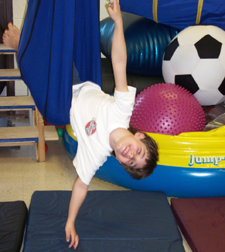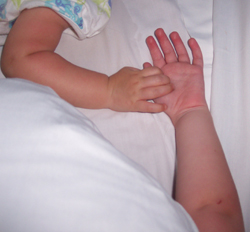
|
Pediatric Occupational, Physical, ABA/Behavioral, Feeding, Speech, and Language Therapies Main Clinic: 931-372-2567 1445 East 10th Street Cookeville, TN 38501 Email: [email protected] HIPAA Secure Email: [email protected] Fax: (931) 372-2572 ABA Clinic: 931-201-9534 400 Dubois Road Cookeville, TN 38501 Email: [email protected] Please call today to get started! Most insurances accepted! |

|
| Who needs therapy? | SE HABLA ESPAÑOL |
Picky about clothing, food, and touch on skin or mouth?
Tactile defensiveness: overly sensitive to touch

-
Does your child hate to walk barefoot, even in the house; or can't stand his feet touched by someone?
-
Does he refuse to touch anything sticky, slimy, or dirty with their hands?
-
Avoid playing in foods when an infant or toddler?
-
Must the child have the label tags cut out of every piece of clothing and very concerned about the feel of fabric?
-
Does the child hate bathing or washing with a washcloth or soap?
-
Is washing, cutting or simply brushing the child's hair a major battle of crying and screaming?
-
Does they avoid their face touched for any reason?
-
Do they hate anything around their neck such as a shirt collar or jewelry?
-
Does they dislike certain textures or temperature of foods?
-
Fuss about teeth brushed or dental visits?
These questions all relate to the topic of tactile defensiveness or Sensory Modulation Disorder. The root cause is neurological disorganization in the midbrain region of the brain which is largely responsible for filtering incoming stimuli, and, may not adequately screen out all extraneous tactile stimulation causing the child to perceive the input as extreme and uncomfortable.
The central nervous system's ability to process tactile sensory input is distorted causing the child great discomfort. Their brain may register even the most subtle sensations as extreme irritation or even painful and he may respond in an abnormally reactive way such as grimacing or pulling away from the stimulus.
The central nervous system must rely on five sensory nerve receptors in the skin to keep it informed about its environment. These receptors are; light touch (surface), pressure (deep), temperature (hot & cold) and pain. It is quite possible for one type of receptor to be sensitive and the other normalized.
The tactile defensive individual who experiences this extreme sensory registration can have great distress in daily living. This discomfort may be compared to the experience of trimming your fingernails too close. The raw sensation experienced by nerves that are no longer protected by the fingernail can be very irritating. Imagine if just wearing certain clothing textures made you feel pain like this sensation?
This is similar to the way that a person with extreme touch sensitivity may experience sensations, except for two important differences. First, in the case of the person who just clipped their nails, the discomfort comes because the nerves that have been sheltered are now exposed making the person acutely aware of sensations he does not ordinarily feel. The nerve function is normal, but the experience is abnormal. For a person who is overly sensitive to touch the experiences are normal and the nerve function is abnormal. Second, the person who has clipped his nails will soon become accustomed to the sensation, while the person with the over sensitive system does not accommodate to the sensations no matter how much exposure he has. Because of this he may feel bombarded by dozens of unpleasant sensory experiences on a daily basis.
This child may be constantly aware of the clothes on his body to the point of distraction. He may be unable to concentrate on school work because his filtering system is not screening out the feel of the hard chair, the bumps on the pencil, the sharp edges of the paper, the air current blowing through the room, etc. This child may dread art projects that include finger painting, glue, and clay.
This child might want to dress from head to toe in soft sweat clothes, even in hot weather, as this prevents his skin from being exposed to tactile stimulation and decrease the sensory invasion of his nervous system. The slightest accidental bump from another person may feel like a threat and he may lash out in defense. It may appear that he is impulsive, hitting others, but no one understands that he is fighting against the perceived raid of his space as interpreted by his brain.
He may dislike group games like tag or dodge ball, or holding hands with a partner can be agonizing. He may be afraid of the possibility of being touched by another child. He may want to stand apart from others to prevent being bumped and this prevents him from being able to interact with friends in a normal way.
Adults who experience this type of hypersensitivity may have problems in their relationships. Even when appropriate, they still might not want to hug or hold hands with their partners. Normal daily physical contact may cause annoyance and aversion. Wanting to only talk and not touch physically can negatively impact adult relationships. Surprise touches, especially when approached from behind, can cause distress and the person may respond with a punch. The adult who has these problems probably does not intend to be withholding or withdrawn, but this is the only way his nervous system can handle personal interactions.
The individual who is tactile defensive may also experience other problems such as coordination problems, wet the bed, speech and language delays, gets dizzy easy, easily confused, overwhelmed, experience hand-eye coordination difficulties, and motor planning issues.
The good news is that help is available!
The answer is Occupational Therapy with Sensory Integration based intervention!
SENSORY INTEGRATION is a process of calming and stimulating the central nervous system to eliminate the disorganization normalizing sensory input.
An individualized eclectic program is designed and you, the parent, are taught how to implement the activities as your home program. You are taught the how and why and given the on going support needed.
You are given the resources and tools to help your child normalize their responses to touch!
Site empowered by
WebOnTheFly